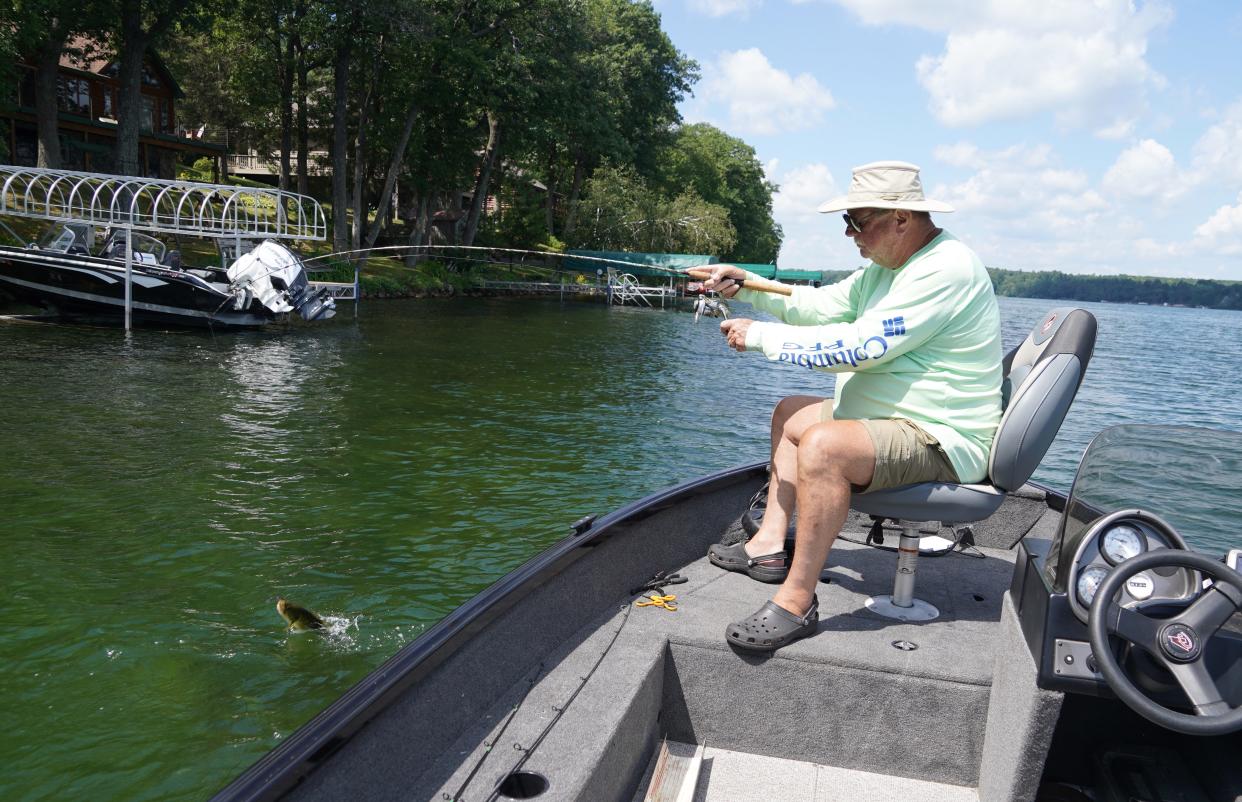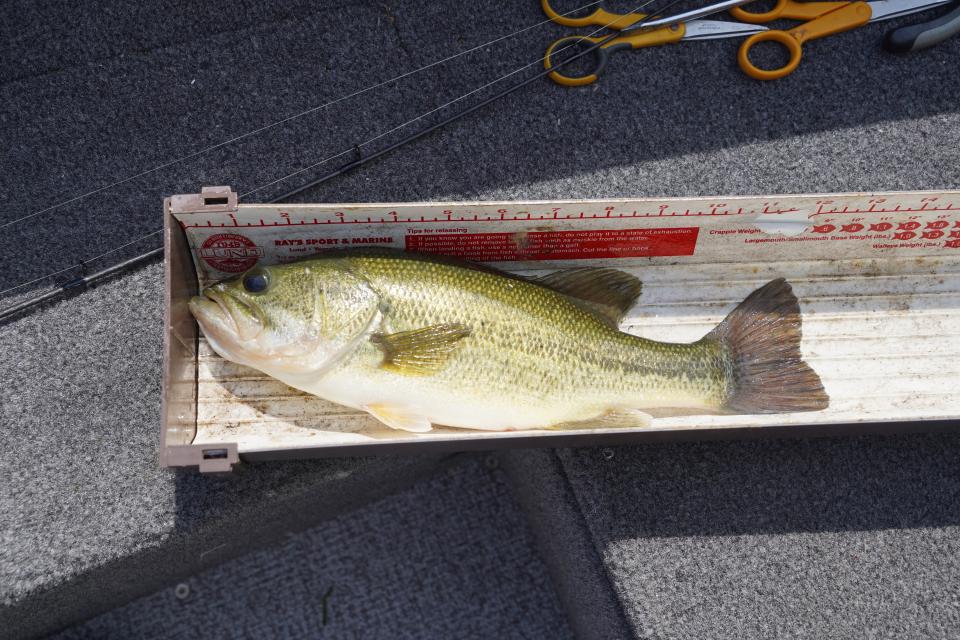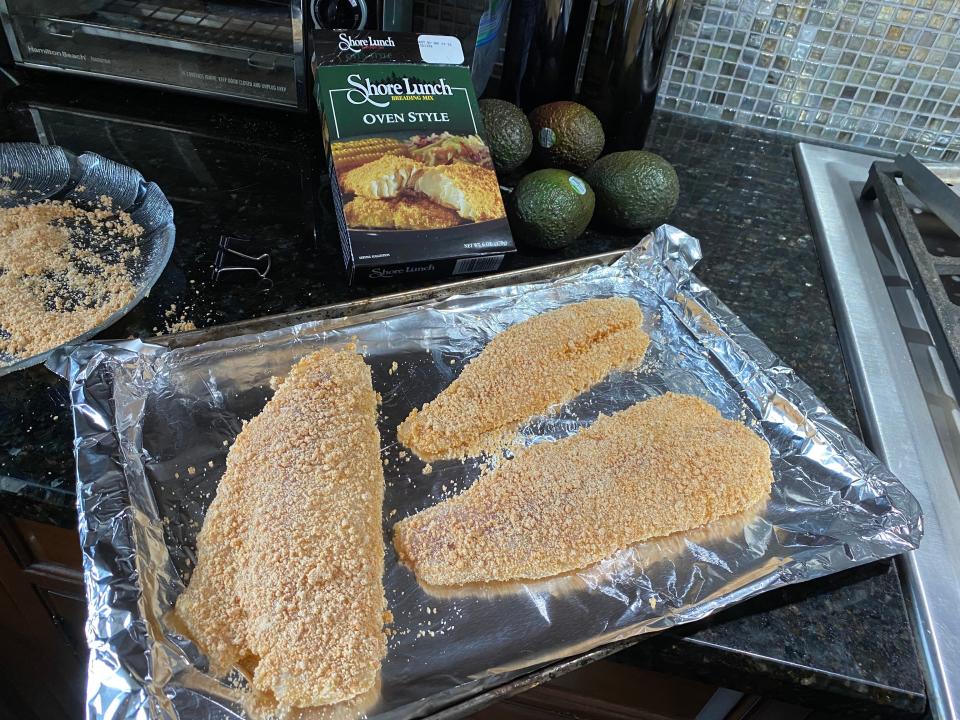Smith: Selective harvest of largemouth bass is a guidepost for Wisconsin's fishing future

ST. CROIX FALLS - The late July day was right out of a Chamber of Commerce brochure.
Sunshine glittered like diamonds on the Wisconsin lake while puffy white clouds paraded across a cobalt sky.
An angler's rod arced, a chunky fish leaped clear of the water and the call of "got another one" filled the air.
Mike Yurk of Hudson and I knew we were fortunate to be actors in the scene.
The outing on Deer Lake near St. Croix Falls had blessed us with not only beautiful weather and fine camaraderie in the great outdoors but with a fish catching frenzy.
We cast 1/16-ounce jigs tipped with pork-rind frogs into the shaded shallows and on every third cast we got a hit. Or tossed the same bait out toward weed edges in 5 to 15 feet of water and had the same result.
The eager fish — largemouth bass — were seemingly everywhere. Most were from 8 to 13 inches in length.
More: Smith: A Cedarburg fisherman in a kayak beat the odds to win the Salmon-A-Rama grand prize
More: Smith: Walleye book takes in-depth look at the pressures facing our favorite species
While not trophies, some were definitely keepers in my book.
In fact this size class and abundance of bass are the reasons I twist Yurk's arm at least once a year to head out to Deer Lake or another, similar water in northwestern Wisconsin.
The two keys are: lots of bass and special regulations that encourage angler harvest of smaller fish.
On Deer Lake, there is no minimum size limit but bass between 14 and 18 inches must be released. The daily bag limit is five bass.
"I'm not one who targets only trophies," said Yurk, a retired U.S. Army major who was raised in Oshkosh and later settled in Hudson with his wife Becky, a.k.a. the "Bass Queen." "I think anglers can miss a lot of the best fishing if they are only out for the biggest fish."
Yurk, who was stationed in southern U.S. states with storied bass waters as well as overseas, said one of his happiest surprises when he started exploring lakes in northwestern Wisconsin was the high quality of the bass fishing.
"It was, and is, better than anywhere I've ever lived," Yurk said.
Largemouth bass are doing so well on many lakes in the region, in fact, that regulations have been put in place to encourage angler harvest.

This runs counter to the long-standing catch-and-release ethic employed by most bass anglers. It also flies in the face of a folk lore that largemouth aren't good eating.
They are delicious.
I hadn't kept a bass in more than 30 years until 2013 when I visited a special regulation bass lake in Burnett County. I kept a couple 13.5-inch-long largemouths and it changed my entire perception of the species.
They are prolific and, unlike walleyes, are projected to have a very bright future in Wisconsin's waters.
It's a matter of choosing waters that can best support harvest.
In 2012, for example, the minimum size limit was removed for bass on most lakes in Burnett and Washburn counties. Deer Lake had its regulation changed in 2018.
The statewide minimum bass size limit is 14 inches.
A 2015 Department of Natural Resources fisheries assessment found the largemouth population on Deer was high in abundance but had small size structure and poor growth rates.
The catch per effort of bass 8 inches or longer was 65 fish per mile in the 2015 survey, which ranked in the 96th percentile when compared to other similar-sized lakes in Wisconsin.
Yet it had just 0.7 bass per mile that were 15 inches or longer, putting it in the 17th percentile.
And it takes a largemouth 9 years to reach 14 inches in length on Deer, 50% longer than the average on northern Wisconsin waters, according to DNR data.
So on certain lakes, it makes sense for every reason for fish-eating anglers to keep some largemouth.
If you didn't know, largemouth are in the same family with black crappie, a panfish widely-desired for its food value.
So it should come as no surprise that a 12- or 13-inch largemouth tastes as good, if not better, than crappie. In my opinion largemouth are equal to walleye as table fare.
But the largemouth resource is more abundant and sustainable.
In the Wisconsin fishing landscape of 2022, there is no better selective harvest opportunity than largemouth bass on lakes with no-minimum size limit.

The 12- to 13.9-inch bass are plump, yield nicely-sized fillets (or ample portions of meat if you prefer to cook the fish whole) and are delicious.
The flesh of bass is flaky and white.
It doesn't matter when you catch them. What matters is how you handle them.
It's pretty simple: get them on ice as fast as possible. The same holds, by the way, for any species of fish.
Yurk and I enjoyed the catching through late morning, then moved to the middle of the lake where we drifted and enjoyed sandwiches for lunch.
In early afternoon we fished drop shots on the outside of a weedline in 20 feet of water, catching a mix of bass and bluegills. The wind gusted to 25 miles an hour at times so we moved to a sheltered bay.
There we found more bass and bluegills and a few rock bass. A 17-inch largemouth, the biggest of the day, hit a Ned-rigged plastic worm I tossed to a clump of vegetation in 8 feet of water.
Over five hours on the water we caught and released about 75 largemouth. Four others – between 12.5 and 13.5 inches – came home with me.
If you haven't eaten a Wisconsin largemouth bass recently, give it a try. Harvest it from a lake with an abundant population, especially a water with special regulations that encourage anglers to keep bass, and make sure to get it on ice quickly.

I think you, like me, will get hooked on this sustainable fishing opportunity in the Badger State.
Here are three recipes that have become staples for me for Wisconsin fish, including panfish, walleye and in recent years, largemouth bass.
Mustard and Mayo Bass: In a bowl, mix equal amounts of Dijon mustard (or other mustard of your choice) and mayonnaise. The mixture should be of sufficient quantity to coat the fillets you intend to cook.
Next, lightly coat fillets with vegetable oil of your choice, then slather the mustard/mayo mixture on both sides of the fillets. Sprinkle the top of the fillets with pepper or other seasoning of your choice.
Finally, bake the fillets in a 400-degree oven until they flake easily with the touch of a fork, usually about 10 minutes. They may also be cooked on a grill. I typically place them on aluminum foil and cook them on a rack over the coals or burner.
The mustard/mayo coating helps keep the flesh moist and in my opinion provides a very nice flavor note to the fish.
Teriyaki Bass: Pour enough teriyaki marinade in a bowl to cover bass fillets, then add fillets and place bowl in a refrigerator for an hour or two.
I've become a fan of two products, Veri Veri Teriyaki and Soyaki, both marinades that include sesame seeds. But many other teriyaki products are commercially-available. Another alternative is make your own marinade starting with soy sauce.
About 15 minutes before meal time, pull filets out of the marinade and place them in a glass or metal pan and cook in a 400-degree oven until they begin to flake, usually 8 to 10 minutes. The slightly sweet, slightly tangy marinade enhances without overpowering the taste of the fish.
I've also used this recipe to cook fish on a grate over a campfire. The home grill is another option.
Oven-baked Bass: Fried fish is a staple in Wisconsin restaurants and homes. But here's an excellent alternative that to me tastes even better than any product cooked in oil and comes without the mess.
Beat one egg and place it in a bowl. Dip the bass filets in the egg, then coat filets with a seasoned breading mixture.
I like a product called Shore Lunch Oven Style. You could also make your own with bread or panko crumbs and seasoning.
Then bake the coated filets for 10 to 15 minutes in a 400-degree oven. The result is a filet that's moist inside with a thin, slightly crispy outer coating that isn't overbearing. It's as good – I'd argue better – as any fish fry.
Or try using largemouth bass in place of walleye in your favorite recipe. If the bass has been handled and prepared well, I think you'll be very pleased with the results on your plate. Remember: get them on ice as quickly as possible after the catch.
And by selectively harvesting largemouth bass on certain lakes, you'll be enjoying a sustainable, prolific resource while taking pressure off walleyes and helping improve the bass size structure.
For a list of lakes with special regulations that encourage the harvest of largemouth bass, check the DNR's fishing pamphlet at dnr.wi.gov.
Let me know what you think of catching and keeping more largemouth bass on Wisconsin lakes with no minimum size limit by emailing psmith@jrn.com.
THANK YOU: Subscribers' support makes this work possible. Help us share the knowledge by buying a gift subscription.
DOWNLOAD THE APP: Get the latest news, sports and more
This article originally appeared on Milwaukee Journal Sentinel: Selective harvest of largemouth bass guidepost for Wisconsin's future

